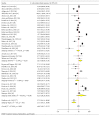Drug Resistance Patterns of Escherichia coli in Ethiopia: A Meta-Analysis
- PMID: 29854757
- PMCID: PMC5960519
- DOI: 10.1155/2018/4536905
Drug Resistance Patterns of Escherichia coli in Ethiopia: A Meta-Analysis
Abstract
Background: Antimicrobial drug resistance is a global threat for treatment of infectious diseases and costs life and money and threatens health delivery system's effectiveness. The resistance of E. coli to frequently utilized antimicrobial drugs is becoming a major challenge in Ethiopia. However, there is no inclusive countrywide study. Therefore, this study intended to assess the prevalence of E. coli resistance and antimicrobial-specific resistance pattern among E. coli clinical isolates in Ethiopia.
Methods: Articles were retrieved from PubMed, Embase, and grey literature from 2007 to 2017. The main outcome measures were overall E. coli and drug-specific resistance patterns. A random-effects model was used to determine pooled prevalence with 95% confidence interval (CI), using DerSimonian and Laird method. In addition, subgroup analysis was conducted to improve the outcome. The study bias was assessed by Begg's funnel plot. This study was registered in PROSPERO as follows: PROSPERO 2017: CRD42017070106.
Results: Of 164 articles retrieved, 35 articles were included. A total of 19,235 study samples participated in the studies and 2,635 E. coli strains were isolated. Overall, E. coli antibacterial resistance was 45.38% (95% confidence interval (CI): 33.50 to 57.27). The resistance pattern ranges from 62.55% in Addis Ababa to 27.51% in Tigray region. The highest resistance of E. coli reported was to ampicillin (83.81%) and amoxicillin (75.79%), whereas only 13.55% of E. coli isolates showed resistance to nitrofurantoin.
Conclusion: E. coli antimicrobial resistance remains high with disparities observed among regions. The bacterium was found to be highly resistant to aminopenicillins. The finding implies the need for effective prevention strategies for the E. coli drug resistance and calls for multifaceted approaches with full involvement of all stakeholders.
Figures





References
-
- Wagenlehner F. M., Naber K. G., Weidner W. Rational antibiotic therapy of urinary tract infections. 2008;31(10):385–90. - PubMed
-
- De Francesco M. A., Giuseppe R., Laura P., Riccardo N., Nin M. Urinary tract infections inBrescia, Italy: Etiology of uropathogens and antimicrobial resistance of common Uropathogens. 2007;13(6):136–144. - PubMed
-
- Kashef N., Djavid G. E., Shahbazi S. Antimicrobial susceptibility patterns of community-acquired uropathogens in Tehran, Iran. 2010;4(4):202–206. - PubMed
Publication types
MeSH terms
Substances
LinkOut - more resources
Full Text Sources
Other Literature Sources

